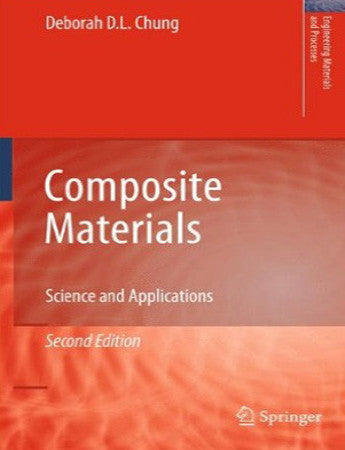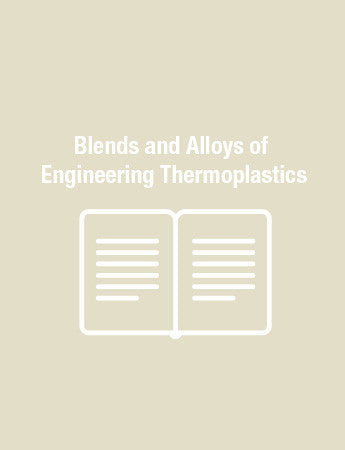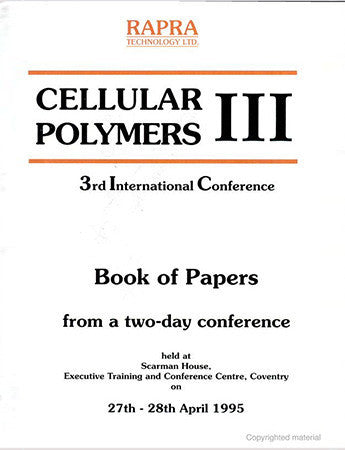Composite Materials
Provides a comprehensive treatment of functional composite materials, covering functions related to the thermal, electrical, electromagnetic, thermoelectric, dielectric, optical, magnetic and electrochemical behaviour.
- The 2nd edition includes an expanded treatment of each topic, particularly in relation to applications and practical considerations.
The applications of composite materials continue to be of increasing importance due to the industry’s need for modern analysis and improved performance. The first edition of Composite Materials introduced a new way of looking at composite materials: covering composites in accordance with their functions. This second edition expands the book’s scope to emphasize application-driven and process-oriented materials development. Although applications are the economical and technological driving force of materials development, processes often determine the feasibility and practicality.
This tutorial-style reference book examines both structural composite materials (including their mechanical properties, durability, and degradation) and functional composite materials (including their electrical, piezoresistive, and thermal properties), as needed for a substantial range of applications. The emphasis on application-driven and process-oriented materials development is enhanced by a large amount of experimental results that provide real illustrations of composite materials development.
Composite Materials is an essential book for researchers and engineers who are interested in materials development for industrial applications. It has a vibrant yet functional approach, making it suitable for both students and practitioners, and provides a full explanation of all of the fundamental concepts related to the structural and functional properties covered.
The Engineering Materials and Processes series focuses on all forms of materials and the processes used to synthesise and formulate them as they relate to the various engineering disciplines. The series deals with a diverse range of materials: ceramics; metals (ferrous and non-ferrous); semiconductors; composites, polymers, biomimetics etc. Each monograph in the series is written by a specialist and demonstrates how enhancements in materials and the processes associated with them can improve performance in the field of engineering in which they are used.
- The 2nd edition includes an expanded treatment of each topic, particularly in relation to applications and practical considerations.
The applications of composite materials continue to be of increasing importance due to the industry’s need for modern analysis and improved performance. The first edition of Composite Materials introduced a new way of looking at composite materials: covering composites in accordance with their functions. This second edition expands the book’s scope to emphasize application-driven and process-oriented materials development. Although applications are the economical and technological driving force of materials development, processes often determine the feasibility and practicality.
This tutorial-style reference book examines both structural composite materials (including their mechanical properties, durability, and degradation) and functional composite materials (including their electrical, piezoresistive, and thermal properties), as needed for a substantial range of applications. The emphasis on application-driven and process-oriented materials development is enhanced by a large amount of experimental results that provide real illustrations of composite materials development.
Composite Materials is an essential book for researchers and engineers who are interested in materials development for industrial applications. It has a vibrant yet functional approach, making it suitable for both students and practitioners, and provides a full explanation of all of the fundamental concepts related to the structural and functional properties covered.
The Engineering Materials and Processes series focuses on all forms of materials and the processes used to synthesise and formulate them as they relate to the various engineering disciplines. The series deals with a diverse range of materials: ceramics; metals (ferrous and non-ferrous); semiconductors; composites, polymers, biomimetics etc. Each monograph in the series is written by a specialist and demonstrates how enhancements in materials and the processes associated with them can improve performance in the field of engineering in which they are used.
Contents
1 Composite Material Structure and Processing
1.1 Introduction
1.2 CompositeMaterialStructure
1.2.1 Continuous Fiber Composites
1.2.2 Carbon–CarbonComposites
1.2.3 Cement-MatrixComposites
1.3 Processing of Composite Materials
1.3.1 Polymer-MatrixComposites
1.3.2 Metal-MatrixComposites
1.3.3 Carbon-MatrixComposites
1.3.4 Ceramic-MatrixComposites
1.3.5 Cement-MatrixComposites
1.4 Composite Design Concepts
1.5 ApplicationsofCompositeMaterials
ReviewQuestions
References
FurtherReading
2 Carbon Fibers and Nanofillers
2.1 Carbons
2.2 CarbonFibers
2.3 Nanofillers
ReviewQuestions
FurtherReading
3 Mechanical Properties
3.1 Property Requirements
3.2 Basic Mechanical Properties
3.2.1 Modulus of Elasticity
3.2.2 Strength
3.2.3 Ductility
3.3 Effect of Damage on the Mechanical Properties
3.4 Brittlevs.DuctileMaterials
3.5 Strengthening
3.6 VibrationDampingAbility
3.6.1 Introduction
3.6.2 Viscoelastic Behavior
3.6.3 Pseudoplasticity and Ferroelasticity
3.6.4 Interfacial Damping
3.6.5 Structural Materialsfor Damping
3.6.6 Comparison of Materials Utilized for Damping
3.6.7 Emerging Materials for Damping
ReviewQuestions
References
FurtherReading
4. Durability and Degradation of Materials
4.1 CorrosionResistance
4.1.1 IntroductiontoElectrochemicalBehavior
4.1.2 CorrosionProtection
4.2 ElevatedTemperatureResistance
4.2.1 TechnologicalRelevance
4.2.2 Effects of ThermalDegradation
4.2.3 Origins of Thermal Degradation
4.2.4 Effects of Temperature on the Composite Microstructure
4.2.5 Improving the Elevated Temperature Resistance
4.2.6 Investigation of Elevated TemperatureResistance
4.3 FatigueResistance
4.3.1 MechanicalFatigue
4.3.2 ThermalFatigue
4.4 Durability
ReviewQuestions
References
FurtherReading
5. Materials for Lightweight Structures, Civil Infrastructure, Joining and Repair
5.1 Materials for Light weight Structures
5.1.1 Composites with Polymer,Carbon,Ceramic and Metal Matrices
5.1.2 Cement-MatrixComposites
5.2 Materials for Civil Infrastructure
5.3 Materials for Joining
5.3.1 Sintering or Autohesion
5.3.2 Welding
5.3.3 Brazing and Soldering
5.3.4 Adhesion
5.3.5 CementitiousJoining
5.3.6 Joining Using Inorganic Binders
5.3.7 Joining Using Carbon Binders
5.3.8 Fastening
5.3.9 ExpansionJoints
5.4 Materials Used for Repair
5.4.1 Patching
5.4.2 Wrapping
5.4.3 Self-healing
Review Questions
References
Further Reading
6 Tailoring Composite Materials
6.1 Tailoring by Component Selection
6.1.1 Polymer-MatrixComposites
6.1.2 Cement-MatrixComposites
6.1.3 Metal-MatrixComposites.
6.2 Tailoring by Interface Modification
6.2.1 Interface Bond Modification
6.2.2 Interface Composition Modification
6.2.3 Interface Microstructure Modification
6.3 Tailoring by Surface Modification
6.4 Tailoring by Microstructure Control
6.4.1 Crystallinity Control
6.4.2 Porosity Control
6.5 Tailoring by Organic–Inorganic Nanoscale Hybridization
6.5.1 Nanocomposites with Organic Solid Nanoparticles Dispersed in an Inorganic Matrix
6.5.2 Nanocomposites with an Organic Component Dispersed in an Inorganic Matrix Where the Organic Component is Added as a Liquid
6.5.3 Nanocomposites Made by Inorganic Component Exfoliation and Subsequent Organic Component Adsorption
Review Questions
References
Further Reading
7 Electrical Properties
7.1 Origin of Electrical Conduction
7.2 VolumeElectricalResistivity
7.3 Calculating the Volume Electrical Resistivity of a Composite Material
7.3.1 Parallel Configuration
7.3.2 Series Configuration
7.4 Contact Electrical Resistivity
7.5 Electric Power and Resistance Heating
7.5.1 Scientific Basis
7.5.2 Self-Heating Structural Materials
7.6 Effect of Temperature on the Electrical Resistivity
7.6.1 Scientific Basis
7.6.2 Structural Materials Used as Thermistors
7.7 Effect of Strain on the Electrical Resistivity (Piezoresistivity)
7.7.1 Scientific Basis
7.7.2 Effects of Strain and Strain-Induced Damage on the Electrical Resistivity of Polymer-Matrix Structural Composites
7.8 See beck Effect
7.8.1 Scientific Basis
7.8.2 Thermoelectric Composites
7.9 Applications of Conductive Materials
7.9.1 Overview of Applications
7.9.2 Microelectronic Applications
7.9.3 Electrochemical Applications
7.10 Conductive Phase Distribution and Connectivity
7.10.1 Effect of the Conductive Filler Aspect Ratio
7.10.2 Effect of the Nonconductive Thermoplastic Particle Viscosity
7.10.3 Effect of Conductive Particle Size
7.10.4 Effect of Additives
7.10.5 Levels of Percolation
7.11 Electrically Conductive Joints
7.11.1 Mechanically Strong Joints for Electrical Conduction
7.11.2 Mechanically Weak Joints for Electrical Conduction
7.11.3 Electrical Connection Through Pressure Application
7.11.4 Electrical Connection Through aZ-Axis Electrical Conductor
7.12 Porous Conductors
7.12.1 Porous Conductors Without a Nonconductive Filler
7.12.2 Porous Conductors With a Nonconductive
Filler and a Conductive Additive
Review Questions
References
Further Reading
8. Thermal Properties
8.1 Thermal Expansion
8.2 Specific Heat
8.3 Phase Transformations
8.3.1 Scientific Basis
8.3.2 Shape Memory Effect
8.3.3 Calorimetry
8.4 Thermal Conductivity
8.5 Thermal Conductance of an Interface
8.6 Evaluating the Thermal Conduction
8.6.1 Guarded Hot Plate Method
8.6.2 Laser Flash Method
8.7 Thermal Interface Materials
8.8 Composites Used for Microelectronic Heat Sinks
8.8.1 Metals, Diamond, and Ceramics
8.8.2 Metal-Matrix Composites
8.8.3 Carbon-Matrix Composites
8.8.4 Carbon and Graphite
8.8.5 Ceramic-Matrix Composites
8.8.6 Polymer-Matrix Composites
8.9 Carbon Fiber Polymer-Matrix Composites for Aircraft Heat Dissipation
8.9.1 Interlaminar Interface Nanostructuring
8.9.2 Through-ThicknessThermal Conductivity
8.9.3 Through-Thickness Compressive Properties
8.9.4 FlexuralProperties
8.10 Composites Used for Thermal Insulation
ExampleProblems
ReviewQuestions
References
FurtherReading
Appendix: Test
TestQuestions
PartI(32%)
PartII(68%)
TestSolutions
PartI(32%)
PartII(68%)
Index
1 Composite Material Structure and Processing
1.1 Introduction
1.2 CompositeMaterialStructure
1.2.1 Continuous Fiber Composites
1.2.2 Carbon–CarbonComposites
1.2.3 Cement-MatrixComposites
1.3 Processing of Composite Materials
1.3.1 Polymer-MatrixComposites
1.3.2 Metal-MatrixComposites
1.3.3 Carbon-MatrixComposites
1.3.4 Ceramic-MatrixComposites
1.3.5 Cement-MatrixComposites
1.4 Composite Design Concepts
1.5 ApplicationsofCompositeMaterials
ReviewQuestions
References
FurtherReading
2 Carbon Fibers and Nanofillers
2.1 Carbons
2.2 CarbonFibers
2.3 Nanofillers
ReviewQuestions
FurtherReading
3 Mechanical Properties
3.1 Property Requirements
3.2 Basic Mechanical Properties
3.2.1 Modulus of Elasticity
3.2.2 Strength
3.2.3 Ductility
3.3 Effect of Damage on the Mechanical Properties
3.4 Brittlevs.DuctileMaterials
3.5 Strengthening
3.6 VibrationDampingAbility
3.6.1 Introduction
3.6.2 Viscoelastic Behavior
3.6.3 Pseudoplasticity and Ferroelasticity
3.6.4 Interfacial Damping
3.6.5 Structural Materialsfor Damping
3.6.6 Comparison of Materials Utilized for Damping
3.6.7 Emerging Materials for Damping
ReviewQuestions
References
FurtherReading
4. Durability and Degradation of Materials
4.1 CorrosionResistance
4.1.1 IntroductiontoElectrochemicalBehavior
4.1.2 CorrosionProtection
4.2 ElevatedTemperatureResistance
4.2.1 TechnologicalRelevance
4.2.2 Effects of ThermalDegradation
4.2.3 Origins of Thermal Degradation
4.2.4 Effects of Temperature on the Composite Microstructure
4.2.5 Improving the Elevated Temperature Resistance
4.2.6 Investigation of Elevated TemperatureResistance
4.3 FatigueResistance
4.3.1 MechanicalFatigue
4.3.2 ThermalFatigue
4.4 Durability
ReviewQuestions
References
FurtherReading
5. Materials for Lightweight Structures, Civil Infrastructure, Joining and Repair
5.1 Materials for Light weight Structures
5.1.1 Composites with Polymer,Carbon,Ceramic and Metal Matrices
5.1.2 Cement-MatrixComposites
5.2 Materials for Civil Infrastructure
5.3 Materials for Joining
5.3.1 Sintering or Autohesion
5.3.2 Welding
5.3.3 Brazing and Soldering
5.3.4 Adhesion
5.3.5 CementitiousJoining
5.3.6 Joining Using Inorganic Binders
5.3.7 Joining Using Carbon Binders
5.3.8 Fastening
5.3.9 ExpansionJoints
5.4 Materials Used for Repair
5.4.1 Patching
5.4.2 Wrapping
5.4.3 Self-healing
Review Questions
References
Further Reading
6 Tailoring Composite Materials
6.1 Tailoring by Component Selection
6.1.1 Polymer-MatrixComposites
6.1.2 Cement-MatrixComposites
6.1.3 Metal-MatrixComposites.
6.2 Tailoring by Interface Modification
6.2.1 Interface Bond Modification
6.2.2 Interface Composition Modification
6.2.3 Interface Microstructure Modification
6.3 Tailoring by Surface Modification
6.4 Tailoring by Microstructure Control
6.4.1 Crystallinity Control
6.4.2 Porosity Control
6.5 Tailoring by Organic–Inorganic Nanoscale Hybridization
6.5.1 Nanocomposites with Organic Solid Nanoparticles Dispersed in an Inorganic Matrix
6.5.2 Nanocomposites with an Organic Component Dispersed in an Inorganic Matrix Where the Organic Component is Added as a Liquid
6.5.3 Nanocomposites Made by Inorganic Component Exfoliation and Subsequent Organic Component Adsorption
Review Questions
References
Further Reading
7 Electrical Properties
7.1 Origin of Electrical Conduction
7.2 VolumeElectricalResistivity
7.3 Calculating the Volume Electrical Resistivity of a Composite Material
7.3.1 Parallel Configuration
7.3.2 Series Configuration
7.4 Contact Electrical Resistivity
7.5 Electric Power and Resistance Heating
7.5.1 Scientific Basis
7.5.2 Self-Heating Structural Materials
7.6 Effect of Temperature on the Electrical Resistivity
7.6.1 Scientific Basis
7.6.2 Structural Materials Used as Thermistors
7.7 Effect of Strain on the Electrical Resistivity (Piezoresistivity)
7.7.1 Scientific Basis
7.7.2 Effects of Strain and Strain-Induced Damage on the Electrical Resistivity of Polymer-Matrix Structural Composites
7.8 See beck Effect
7.8.1 Scientific Basis
7.8.2 Thermoelectric Composites
7.9 Applications of Conductive Materials
7.9.1 Overview of Applications
7.9.2 Microelectronic Applications
7.9.3 Electrochemical Applications
7.10 Conductive Phase Distribution and Connectivity
7.10.1 Effect of the Conductive Filler Aspect Ratio
7.10.2 Effect of the Nonconductive Thermoplastic Particle Viscosity
7.10.3 Effect of Conductive Particle Size
7.10.4 Effect of Additives
7.10.5 Levels of Percolation
7.11 Electrically Conductive Joints
7.11.1 Mechanically Strong Joints for Electrical Conduction
7.11.2 Mechanically Weak Joints for Electrical Conduction
7.11.3 Electrical Connection Through Pressure Application
7.11.4 Electrical Connection Through aZ-Axis Electrical Conductor
7.12 Porous Conductors
7.12.1 Porous Conductors Without a Nonconductive Filler
7.12.2 Porous Conductors With a Nonconductive
Filler and a Conductive Additive
Review Questions
References
Further Reading
8. Thermal Properties
8.1 Thermal Expansion
8.2 Specific Heat
8.3 Phase Transformations
8.3.1 Scientific Basis
8.3.2 Shape Memory Effect
8.3.3 Calorimetry
8.4 Thermal Conductivity
8.5 Thermal Conductance of an Interface
8.6 Evaluating the Thermal Conduction
8.6.1 Guarded Hot Plate Method
8.6.2 Laser Flash Method
8.7 Thermal Interface Materials
8.8 Composites Used for Microelectronic Heat Sinks
8.8.1 Metals, Diamond, and Ceramics
8.8.2 Metal-Matrix Composites
8.8.3 Carbon-Matrix Composites
8.8.4 Carbon and Graphite
8.8.5 Ceramic-Matrix Composites
8.8.6 Polymer-Matrix Composites
8.9 Carbon Fiber Polymer-Matrix Composites for Aircraft Heat Dissipation
8.9.1 Interlaminar Interface Nanostructuring
8.9.2 Through-ThicknessThermal Conductivity
8.9.3 Through-Thickness Compressive Properties
8.9.4 FlexuralProperties
8.10 Composites Used for Thermal Insulation
ExampleProblems
ReviewQuestions
References
FurtherReading
Appendix: Test
TestQuestions
PartI(32%)
PartII(68%)
TestSolutions
PartI(32%)
PartII(68%)
Index
Deborah D.L. Chung is Professor in the Department of Mechanical and Aerospace Engineering at the University of Buffalo, USA. She has a PhD in Materials Science from the Massachusetts Institute of Technology, USA.




